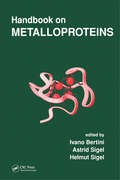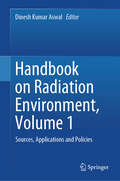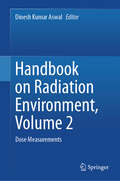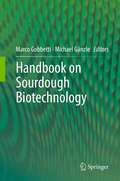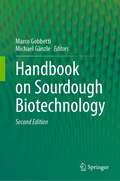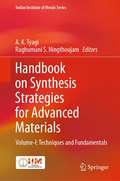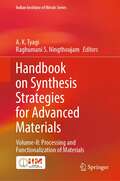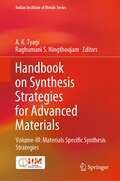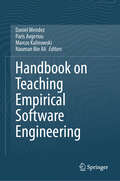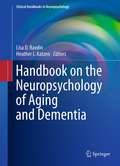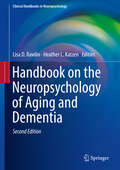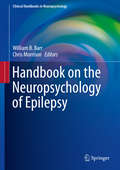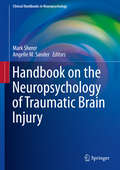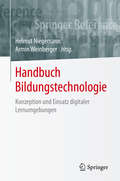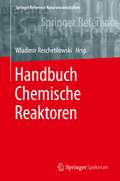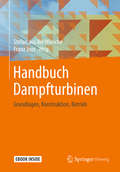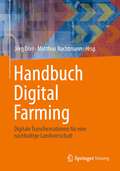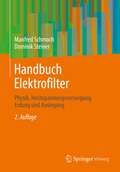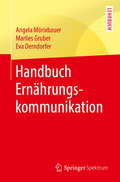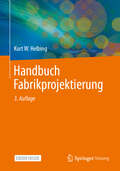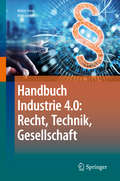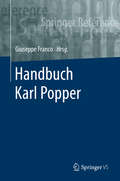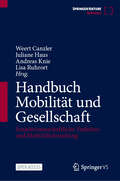- Table View
- List View
Handbook on Metalloproteins
by Ivano Bertini Astrid Sigel Helmut SigelThis Handbook on Metalloproteins focuses on the available structural information of proteins and their metal ion coordination spheres. It centers on the metal ions indispensable for life but also considers metal ions used as substitution probes in studies of metalloproteins. Emphasizing the structure-function relationship, the book covers the commo
Handbook on Radiation Environment, Volume 1: Sources, Applications and Policies
by Dinesh Kumar AswalThis handbook provides a comprehensive review of radiation present in the environment, its sources, dose measurement techniques, exposures in natural and man-made radiation environments, policies governing radiation safety, societal applications of radiation technology, radiological and nuclear events, preparedness, response, and mitigation of radiation emergencies. It covers natural and man-made radiation environment with an emphasis on renewed interest in nuclear energy as a clean and green source of power generation. Additionally, it reviews various approaches to understand the fate and behaviour of radionuclides in the terrestrial and aquatic ecosystems. It also presents nuclear technology's diverse applications, from diagnostic and therapeutic nuclear medicine to materials modifications and sustainable waste management strategies and the role of ionizing radiation in ensuring food security and safety. The handbook also highlights the existing (internationally adopted) radiation protection policies, which are originated from linear-no-threshold (LNT) model of dose-response characteristics. The scientific basis of LNT-model and its limitations at low doses prompts a revision of the exiting radiation protection policies for better utilization of the benefits of ionizing radiation. The handbook serves as a comprehensive resource for students, academicians, scientists, engineers, and policymakers interested in seeking an in-depth knowledge of radiation and the multifaceted applications of radiation technology while protecting human health and the environment.
Handbook on Radiation Environment, Volume 2: Dose Measurements
by Dinesh Kumar AswalThe handbook aims to provide a comprehensive resource for understanding ionizing radiation dosimetry, catering to experts, policymakers, and interested readers. The content of the handbook is focused on two main aspects of dose measurements: external dosimetry and internal dosimetry. The section on external dosimetry covers fundamental principles and discusses monitoring techniques across various environments, such as nuclear, industrial, research, and medical facilities. It also covers advanced topics like Bayesian inference and retrospective dosimetry. The internal dosimetry section explores radionuclide biokinetics, simulation techniques, dose evaluation, and monitoring methods. Specific scenarios, such as radon inhalation and off-normal conditions, are addressed, highlighting the importance of precision and intervention. The handbook serves as a comprehensive resource for students, academicians, scientists, engineers, and policymakers interested in seeking an in-depth knowledge of radiation dose measurements and its multi-faceted aspects in protecting human health and the environment.
Handbook on Sourdough Biotechnology
by Marco Gobbetti Michael GänzleIn the last few decades, many efforts have been made to exploit sourdough's potential for making baked goods. Through the biotechnology of this traditional baking method, many sensory, rheological, nutritional, and shelf-life properties have been discovered and/or rediscovered. Bakery industries are greatly attracted by the potentials that sourdough presents, and new industrial protocols are being developed. To the best of our knowledge, there has been no single book dedicated to sourdough biotechnology, and which clearly demonstrate its potential. This book aims at defining and highlighting the microbiological, technological, nutritional, and chemical aspects of sourdough biotechnology. The book will be the first reference guide on this topic for the worldwide scientific, teaching and students communities, also opening a way of communication and transferring the main results to a more productive industrial application.
Handbook on Sourdough Biotechnology
by Marco Gobbetti Michael GänzleBread and leavened bakery products have been essential to human nourishment for millennia. Traditionally, bread production has relied on the use of sourdough as a leavening agent and to impart a characteristic quality to baked goods. In recent years, improved understanding of the biodiversity and microbial ecology of sourdough microbiota, the discovery of new species, the improved management and monitoring of its meta-community and the commercialization of innovative products have vastly expanded the potential of sourdough fermentation for making baked goods. For example, raw materials such as cereals, pseudo-cereals, ancient grains, and gluten-free substrates, as well as a large number of baked good varieties (e.g., typical and industrial breads, sweet baked goods, gluten-free products) may benefit from advances in sourdough fermentation. In addition, biotechnological tools and culture properties have been discovered to improve both the shelf life and the sensory and textural qualities of baked goods, as well as their nutritional and health-promoting properties.Now in its second edition, the Handbook on Sourdough Biotechnology remains the only book dedicated completely to sourdough biotechnology with the contribution of the most experienced researchers from the field. It reviews the history of sourdough and the potential of sourdough fermentation in the production of bread and baked goods. A thorough discussion of the various processing steps includes the chemical properties of the raw matter, the taxonomy, diversity, and metabolic properties of starter yeasts and lactic acid bacteria, and the effects of sourdough fermentation on the shelf life and the sensory, textural, nutritional, and health-promoting properties of baked goods.
Handbook on Synthesis Strategies for Advanced Materials: Volume-I: Techniques and Fundamentals (Indian Institute of Metals Series)
by A. K. Tyagi Raghumani S. NingthoujamThis book presents state-of-the-art coverage of synthesis of advanced functional materials. Unconventional synthetic routes play an important role in the synthesis of advanced materials as many new materials are metastable and cannot be synthesized by conventional methods. This book presents various synthesis methods such as conventional solid-state method, combustion method, a range of soft chemical methods, template synthesis, molecular precursor method, microwave synthesis, sono-chemical method and high-pressure synthesis. It provides a comprehensive overview of synthesis methods and covers a variety of materials, including ceramics, films, glass, carbon-based, and metallic materials. Many techniques for processing and surface functionalization are also discussed. Several engineering aspects of materials synthesis are also included. The contents of this book are useful for researchers and professionals working in the areas of materials and chemistry.
Handbook on Synthesis Strategies for Advanced Materials: Volume-II: Processing and Functionalization of Materials (Indian Institute of Metals Series)
by A. K. Tyagi Raghumani S. NingthoujamThis book presents state-of-the-art coverage of synthesis of advanced functional materials. Unconventional synthetic routes play an important role in the synthesis of advanced materials as many new materials are metastable and cannot be synthesized by conventional methods. This book presents various synthesis methods such as conventional solid-state method, combustion method, a range of soft chemical methods, template synthesis, molecular precursor method, microwave synthesis, sono-chemical method and high-pressure synthesis. It provides a comprehensive overview of synthesis methods and covers a variety of materials, including ceramics, films, glass, carbon-based, and metallic materials. Many techniques for processing and surface functionalization are also discussed. Several engineering aspects of materials synthesis are also included. The contents of this book are useful for researchers and professionals working in the areas of materials and chemistry.
Handbook on Synthesis Strategies for Advanced Materials: Volume-III: Materials Specific Synthesis Strategies (Indian Institute of Metals Series)
by A. K. Tyagi Raghumani S. NingthoujamThis book presents state-of-the-art coverage of synthesis of advanced functional materials. Unconventional synthetic routes play an important role in the synthesis of advanced materials as many new materials are metastable and cannot be synthesized by conventional methods. This book presents various synthesis methods such as conventional solid-state method, combustion method, a range of soft chemical methods, template synthesis, molecular precursor method, microwave synthesis, sono-chemical method and high-pressure synthesis. It provides a comprehensive overview of synthesis methods and covers a variety of materials, including ceramics, films, glass, carbon-based, and metallic materials. Many techniques for processing and surface functionalization are also discussed. Several engineering aspects of materials synthesis are also included. The contents of this book are useful for researchers and professionals working in the areas of materials and chemistry.
Handbook on Teaching Empirical Software Engineering
by Daniel Mendez Paris Avgeriou Marcos Kalinowski Nauman Bin AliThis handbook exploits the profound experience and expertise of well-established scholars in the empirical software engineering community to provide guidance and support in teaching various research methods and fundamental concepts. A particular focus is thus on combining research methods and their epistemological settings and terminology with didactics and pedagogy for the subject. The book covers the most essential contemporary research methods and philosophical and cross-cutting concerns in software engineering research, considering both academic and industrial settings, at the same time providing insights into the effective teaching of concepts and strategies. To this end, the book is organized into four major parts. In the first part, the editors set the foundation with two chapters; one laying out the larger context of the discipline for a positioning of the remainder of this book, and one guiding the creation of a syllabus for courses in empirical software engineering. The second part of the book lays the fundamentals for teaching empirical software engineering, addressing more cross-cutting aspects from theorizing and teaching research designs to measurement and quantitative data analysis. In the third part, general experiences and personal reflections from teaching empirical software engineering in different settings are shared. Finally, the fourth part contains a number of carefully selected research methods, presented through an educational lens. Next to the chapter contributions themselves that provide a more theoretical perspective and practical advice, readers will find additional material in the form of, for example, slide sets and tools, in an online material section. The book mainly targets three different audiences: (1) educators teaching empirical software engineering to undergraduate, postgraduate or doctoral students, (2) professional trainers teaching the basic concepts of empirical software engineering to software professionals, and (3) students and trainees attending such courses.
Handbook on the Neuropsychology of Aging and Dementia
by Heather L. Katzen Lisa D. RavdinWith the aging of the baby boomers and medical advances that promote longevity, older adults are rapidly becoming the fastest growing segment of the population. As the population ages, so does the incidence of age related disorders. Many predict that 15% - 20% of the baby-boomer generation will develop some form of cognitive decline over the course of their lifetime, with estimates escalating to up to 50% in those achieving advanced age. Although much attention has been directed at Alzheimer's disease, the most common form of dementia, it is estimated that nearly one third of those cases of cognitive decline result from other neuropathological mechanisms. In fact, many patients diagnosed with Alzheimer's disease likely have co-morbid disorders that can also influence cognition (i.e., vascular cognitive impairment), suggesting mixed dementias are grossly under diagnosed. The Clinical Handbook on the Neuropsychology of Aging and Dementia is a unique work that provides clinicians with expert guidance and a hands-on approach to neuropsychological practice with older adults. The book will be divided into two sections, the first addressing special considerations for the evaluation of older adults, and the second half focusing on common referral questions likely to be encountered when working with this age group. The authors of the chapters are experts and are recognized by their peers as opinion leaders in their chosen chapter topics. The field of neuropsychology has played a critical role in developing methods for early identification of late life cognitive disorders as well as the differential diagnosis of dementia. Neuropsychological assessment provides valuable clinical information regarding the nature and severity of cognitive symptoms associated with dementia. Each chapter will reinforce the notion that neuropsychological measures provide the clinician with sensitive tools to differentiate normal age-related cognitive decline from disease-associated impairment, aid in differential diagnosis of cognitive dysfunction in older adults, as well as identify cognitive deficits most likely to translate into functional impairments in everyday life.
Handbook on the Neuropsychology of Aging and Dementia (Clinical Handbooks in Neuropsychology)
by Heather L. Katzen Lisa D. RavdinThis comprehensive update offers practical advice for professionals working in neuropsychology with older adults. Focusing on fundamentals, common issues, special considerations, and late-life cognitive disorders, respected names in this critical specialty address a wide range of presenting problems and assessment, diagnostic, and treatment concerns. Th roughout, coverage pays keen attention to detail, bringing real-world nuance to large-scale concepts and breaking down complex processes into digestible steps. And like its predecessor, the new Handbook features recommendations for test batteries and ends each chapter by extracting its “clinical pearls.” <P><P>This Second Edition of the Handbook on the Neuropsychology of Aging and Dementia offers a wealth of expert knowledge and hands-on guidance for neuropsychologists, gerontologists, social workers, and other clinicians interested in aging. Th is can be a valuable reference for those studying for board certifi cation in neuropsychology as well as a resource for veteran practitioners brushing up on key concepts in neuropsychology of age related disorders.
Handbook on the Neuropsychology of Epilepsy
by William B. Barr Chris MorrisonThis up-to-date resource offers clinicians a skills-based framework for assessment and treatment of cognitive and emotional problems associated with epilepsy, using current evidence and standardized terminology. Expert coverage reviews widely-used methods for evaluating key aspects of patient functioning (MRI, MEG, electrocortical mapping, the Wada test), and presents guidelines for psychotherapeutic and cognitive remediation strategies in treating comorbid psychiatric conditions. Given the diversity of the patient population, additional chapters spotlight issues specific to subgroups including high- and low-functioning as well as geriatric and pediatric patients. This integrative hands-on approach benefits novice and veteran practitioners across medical and neurological settings seeking guidance on testing, treatment planning, and surgery-related concerns. Topics featured in the Handbook: Neuropsychological assessment across the lifespan. Evaluating the epilepsy surgical candidate: methods and procedures. The Wada test: current perspectives and applications. Assessing psychiatric and personality disorders in the epilepsy patient. Evaluation and management of psychogenic non-epileptic attacks. Neuropsychological assessment with culturally diverse patients. Practical and flexible in its coverage, the Handbook on the Neuropsychology of Epilepsy serves not only neuropsychologists and neurologists but also primary care physicians such as internists, family physicians, and pediatricians.
Handbook on the Neuropsychology of Traumatic Brain Injury
by Mark Sherer Angelle M. SanderThis book collects and synthesizes the latest thinking on the condition in its variety of cognitive and behavioral presentations, matched by a variety of clinical responses. Acknowledging the continuum of injury and the multi-stage nature of recovery, expert contributors review salient research data and offer clinical guidelines for the neuropsychologist working with TBI patients, detailing key areas of impairment, brief and comprehensive assessment methods and proven rehabilitation strategies. Taken together, these chapters provide a framework for best serving a wide range of TBI patients (including children, elders, and patients in multidisciplinary settings) and model treatment that is evidence-based and relevant. A sample of the topics featured in the Handbook: Bedside evaluations in TBI. Outcome assessment in TBI. Collaborating with family caregivers in the rehabilitation of persons with TBI. Behavioral assessment of acute neurobehavioral syndromes to inform treatment. Pediatric TBI: assessment, outcomes, intervention. Special issues with mild TBI in veterans and active duty service members. Expanding professional knowledge on a topic that continues to grow in importance, the Handbook on the Neuropsychology of Traumatic Brain Injury is a premier resource, not only for neuropsychologists but also for other professionals in cognitive care, and trainees entering the field.
Handbuch Betriebliches Umweltmanagement
by Gabi Förtsch Heinz MeinholzIn kompakter Form stellt dieses Handbuch das notwendige Wissen für das betriebliche, nachhaltige Umweltmanagement zur Verfügung. Es ist als Nachschlagewerk zur Einführung und Fortschreibung eines Umweltmanagementsystems konzipiert. Darüber hinaus kann es als Lehrbuch bzgl. der Grundaspekte des betrieblichen Umweltmanagements verwendet werden.
Handbuch Bildungstechnologie: Konzeption und Einsatz digitaler Lernumgebungen
by Armin Weinberger Helmut NiegemannDas Handbuch vermittelt einen umfassenden Überblick über den aktuellen Erkenntnisstand zu Ansätzen und Befunden zur systematischen Gestaltung von Lernumgebungen in deutscher Sprache. Es präsentiert theoretische und methodische Grundlagen der Forschungsdisziplin Bildungstechnologie und stellt darüber hinaus konkrete Überlegungen an, wie diese wissenschaftlichen Grundlagen in praktischen Lehr-Lern-Kontexten umgesetzt werden können. Neben der systematischen Konzeption von Lernangeboten (Instructional Design) liegt ein weiterer Schwerpunkt beim Einsatz aktueller Informations- und Kommunikationstechnik, insbesondere digitaler, interaktiver Medien im Bildungswesen.
Handbuch Chemische Reaktoren: Chemische Reaktionstechnik: Theoretische und praktische Grundlagen, Chemische Reaktionsapparate in Theorie und Praxis (Springer Reference Naturwissenschaften)
by Wladimir ReschetilowskiDieses umfassende Handbuch - in deutscher Sprache einzigartig - stellt die chemische Reaktionstechnik ausführlich vor und behandelt insbesondere die Vielzahl von Chemiereaktoren, die in der chemischen Industrie zum Einsatz kommen, inklusive ökologischer und ökonomischer Aspekte.
Handbuch Dampfturbinen: Grundlagen, Konstruktion, Betrieb
by Stefan aus der Wiesche Franz JoosDas Fachbuch behandelt die Grundlagen, die Konstruktion und das Betriebsverhalten von Dampfturbinen in aktueller Form. Die wichtigsten Fragen zu Dampfturbinen werden als zeitgemäßes Kompendium für fortgeschrittene Studierende, Berufseinsteiger und Ingenieure in der Praxis umfassend und detailliert dargestellt. Nach Grundlagen, Bauteilen und Komponenten werden ausgewählte Ausführungsbeispiele beschrieben und diskutiert. Praxisgerechte Beispiele und Fragen zum Betrieb und Einsatz von Dampfturbinen runden die Darstellung ab.
Handbuch Digital Farming: Digitale Transformationen für eine nachhaltige Landwirtschaft
by Jörg Dörr Matthias NachtmannDas Handbuch Digitale Farming beleuchtet die technologischen, wirtschaftlichen, gesellschaftlichen und rechtlichen Perspektiven der digitalen Transformation. Die Autorinnen und Autoren der einzelnen Kapitel erläutern den Stand der Technik und die Entwicklung von Geschäftsmodellen, so dass die Leserinnen und Leser daraus Schlüsse für ihre eigene Organisation ziehen können. Zudem geben sie einen Ausblick auf Trends und weitere Entwicklungen. Das Handbuch liefert technologische Fakten von renommierten Experten und konkrete Geschäftsbeispiele von erfahrenen Unternehmen und Start-ups. Es richtet sich an Landwirte, Betriebs- und Unternehmensleiter, Entscheider und Entwickler digitaler Tools und Strategien in der Agrar- und Ernährungswirtschaft, sowie an Wissenschaftler und Studierende. Das Handbuch gibt Einblicke in die Diskussion, welchen Beitrag die digitale Landwirtschaft zur Umsetzung des Green Deal, der Farm to Fork Strategie und der neuen Gemeinsamen Agrarpolitik leisten kann.
Handbuch Elektrofilter: Physik, Hochspannungsversorgung, Erdung und Auslegung
by Manfred Schmoch Dominik SteinerDer Leser erhält Informationen zu Anlagen der elektrischen Gasreinigung, wie sie in Kraftwerken, Stahlwerken, Zementwerken, Chemieanlagen, KWK-Anlagen und Biomassekraftwerken betrieben werden.Elektrostatische Abgasfilter stellen hohe Anforderungen an eine sorgfältige und vollständige Erdung. Dabei prallen die teilweise gegensätzlichen Anforderungen der Schutzerde, der Funktionserde und der EMV-Erde aufeinander, die nicht zuletzt durch Normen und Vorschriften festgelegt sind. Das Buch bietet Hintergrundinformationen zu den verschiedenen Erdungsarten sowohl auf technischer als auch auf rechtlicher Ebene. Aus den Anforderungen und Hintergrundinformationen werden die Lösungen für hochwertige Erdungen im Elektrostatischen Abgasfilter abgeleitet, die insgesamt dazu führen, dass das Elektrofilter effizienter arbeitet.
Handbuch Energieeffizienz im Quartier: Clever versorgen, umbauen, aktivieren
by Christa Reicher Anke SchmidtIm Rahmen des Fortschrittskollegs Energieeffizienz im Quartier wurde das Thema von 11 DoktorandInnen unterschiedlicher Disziplinen untersucht. In den Arbeiten werden Lösungsansätze und Empfehlungen für Akteure der Energiewende entwickelt.
Handbuch Ernährungskommunikation
by Angela Mörixbauer Marlies Gruber Eva DerndorferDie Flut an Informationen rund um Ernährung und Lebensmittel führt zu Verwirrung und Verunsicherung, sowohl bei Verbrauchern als auch Fachpersonal. Um erfolgreich seine Botschaften an die jeweilige Zielgruppe zu bringen, bedarf es des Verständnisses über die komplexen Zusammenhänge, Kommunikationsmöglichkeiten, Intentionen der unterschiedlichen Akteure, der differenzierten Ansätze je nach Zielgruppe, Ansprüche an die unterschiedlichen Kanäle sowie der Feinheiten des Kommunikationsmittels.
Handbuch Fabrikprojektierung
by Kurt W. HelbingDieses umfassende und systematisch aufgebaute Handbuch befasst sich mit der ganzheitlichen Projektierung der Produktion in Fabriken. Es behandelt sowohl die Systeme der Produktion für die Teilefertigung und Erzeugnismontage, der Ver- und Entsorgung sowie des Fabrikbetriebes als auch die Erhaltungs- und Materialflusssysteme.Ausgehend vom Produktionsprogramm beschreiben die Autoren, wie die Systeme der Fabrik unter Beachtung praktischer Aspekte durch Funktionsbestimmung, Dimensionierung und Strukturierung entwickelt, optimiert und realisierungsgerecht gestaltet werden. In den Projektierungsmethoden kommen Prinzipien, Grundsätze, Berechnungsvorschriften und Algorithmen zur Anwendung. Dabei steht die Technologische Projektierung im Vordergrund, deren einzelne Phasen, Stufen und Schritte für alle Systeme der Fabrik exakt und reproduzierbar abgearbeitet und durch Beispiele unterstützt werden.Neu in der 3. Auflage (noch zu ergänzen)Die ZielgruppenDieses Buch wendet sich an Technologische Projektanten, Fabrikplaner, Architekten, Investitionsbewerter, Technologen, Werkplaner u.ä. Berufsgruppen, die in der Forschung, in der Lehre oder in der Praxis tätig sind. Angesprochen sind auch Studenten der betreffenden Studien- und Vertiefungsrichtungen.
Handbuch Industrie 4.0: Recht, Technik, Gesellschaft
by Walter FrenzDas Handbuch bietet einen Gesamtüberblick über Industrie 4.0 und gibt zugleich Lösungen für wichtige praktische Fragen. Ausgangspunkt ist dabei das Recht mit seinen aktuellen Herausforderungen Zuordnung der Daten (wem gehören sie? Vorgaben der EU?), Datensicherheit, Datenschutz (Europäische Datenschutzgrundverordnung), Cyberangriffe, Wettbewerbsrecht (Zugangsansprüche gegen Monopolisten, zulässiger und verbotener Informationsaustausch, mögliche Kooperationen). Sodann werden Einzelbereiche von Industrie 4.0 (Internet of Production, Maschinenbau, künstliche Intelligenz, Elektromobilität, autonomes Fahren, Verkehr, Medizin, Bauwesen, Energiewirtschaft etc.) in ihren Besonderheiten beleuchtet. Allgemeine Entwicklungen aus dem Management, der digitalen Transformation der Unternehmen und der Arbeitswelt sowie ethische Fragen schließen sich an.
Handbuch Karl Popper (Springer Reference Geisteswissenschaften Ser.)
by Giuseppe FrancoDieses Handbuch bietet einen verlässlichen, systematischen und umfassenden Zugang einerseits zu Leben und Werk Karl Poppers, andererseits zur breiten Wirkung des Philosophen in Wissenschaft, Politik und Gesellschaft.
Handbuch Mobilität und Gesellschaft: Sozialwissenschaftliche Verkehrs- und Mobilitätsforschung
by Weert Canzler Andreas Knie Lisa Ruhrort Juliane HausDieses Open-Access-Handbuch gibt einen aktuellen Überblick über die sozialwissenschaftliche Forschungslandschaft zum Thema Mobilität und Verkehr. Dabei wird deutlich, was die spezifische sozialwissenschaftliche Sicht auf das Thema ausmacht und wie sich diese von anderen disziplinären Zugängen (etwa der Verkehrsplanung oder der Verkehrsökonomie) abgrenzt. In der gesellschaftlichen, aber auch der wissenschaftlichen Diskussion über Mobilität und Verkehr dominieren bisher immer noch ökonomisch-individualistische Perspektiven auf der einen Seite und planerisch-technische Lösungsansätze auf der anderen Seite. Erst in jüngster Zeit gelingt es vermehrt, auch soziologische und politikwissenschaftliche Perspektiven prominent in die Debatte einzubringen. Das Handbuch will daher das konsolidierte Wissen der sozialwissenschaftlichen Mobilitätsforschung bündeln und kompakt zugänglich machen. Jenseits dieser Konsolidierungsfunktion zeigt Handbuchs den Mehrwert sozialwissenschaftlicher Erkenntnisse für eine Lösung gesellschaftlicher Krisenphänomene, insbesondere der Klimakrise, auf. Dazu soll auch deutlich werden, wie sich sozialwissenschaftliche Mobilitätsforschung über die rein disziplinär-akademische Forschung hinaus in gesellschaftliche Transformationsprozesse einbringt. Neben der Darstellung theoretischer Zugänge und bisheriger Erkenntnisse sollen die Beiträge daher möglichst pointiert Thesen dazu formulieren, unter welchen Bedingungen moderne Gesellschaften ihre Mobilitätssysteme zukünftig gezielt ökologisch und sozial verträglich umbauen können -oder was einem solcher Umbau möglicherweise im Wege steht. Explizit kritische Perspektiven sollen breiten Raum erhalten.
